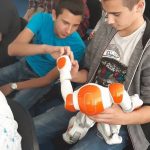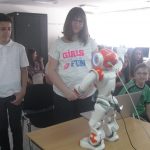Students active participation in the teaching and learning activities is imperative for achieving learning outcomes and acquiring long-lasting knowledge and skills. This is the reason why teachers are always trying to create different activities. They try to implement various teaching strategies in order to raise students’ interest and motivation to learn. This applies not only to classroom teaching, online teaching can be demanding too.

During Covid-19 outbreak many teachers are struggling to find the right way to teach online: to make their teaching interesting and engaging. At first it may seem to be very easy to involve students in online teaching activities since they are ‘digital natives’. They use technology on a regular basis and feel very comfortable ith it. This can be a huge benefit for students, but also a drawback concerning teaching. Sometimes students can find educational tools being boring. The challenge that teachers are facing is enormous. They should find appropriate tools for collaboration, making the learning process interesting at the same time.
Escape Room as a teaching method
Escape Room is a new method that is finding its way into the classrooms, benefiting from the student’s involvement and their raised interest and motivation for solving given tasks. It was very challenging to use this approach without the possibility of physical involvement of the students. We used the digital version of an Escape Room in order to evaluate students’ knowledge in algorithms.
The activity was organized by Georgina Dimova and Maja Videnovic from primary school “Strasho Pindjur” and primary school “Krste Misirkov”. Students from the 6th and 7th grade have been learning about algorithms. The idea to use an Escape Room is just the right tool for revision what they’ve learned. They needed to virtually solve puzzles to break the code. For the creation of the Escape Room, we used the online tool Genially.
Students virtually travelled through the world to find and solve the puzzles. All the puzzles are algorithms that evaluate students higher-order thinking skills (understanding, analyzing, evaluating). Since these puzzles incorporate course material, students had to master this material in order to succeed. It enriched their learning experience and resulted in increased interest and engagement in learning activities. Every puzzle revealed one digit of the code that opened the safe box. The safe box was hiding the secret – How to get a better grade in Computer Science classes? When clicking on it students found a hyperlink leading to a Microsoft Form where they needed to indicate their name, school. The code was set in order to record students’ achievement and receive feedback.
Edmodo – platform for sharing
We shared the Escape Room with the students through Edmodo platform, where we created virtual classrooms with each class. We are using Edmodo during this online teaching period. It is an educational network where teachers and students can share materials, assignments, submissions, tests and give feedback to each other. Using this platform students’ learning is guided and the continuous feedback given contributes to better achievements.
You can try the Escape Room here.
Although it is not a typical Escape Room where students work in groups and develop teamwork and leadership skills, this adoption of the strategy can still be used for empowering students’ problem-solving, and creative thinking skills. Developing computational thinking skill is another benefit not just in terms of learning computer science but also developing 21st century skills in general.
Students have indicated in the virtual classrooms on Edmodo that they liked the activity and enjoyed while playing it. It is the biggest benefit – learning and having fun at the same time. Students were not aware of the educational value; they were just impatient to finish the game and solve the puzzles. Implementation of the Escape Room strategy in the teaching is another proof that game-based learning approach can be beneficial for teachers and students at the same time.
You can find the results of the survey carried out with students in the following file survey digital Escape room





